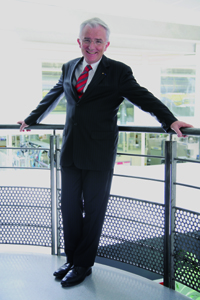
Better battery utilization is a key to the success of the automotive electronics market, which is expected to expand by 7% a year – a percentage that will probably double in the next decade. By 2008, electronics are expected to make up 30% of the value of a car.
“The need for electronics in motor vehicles has grown considerably in recent years to meet increasingly stringent pollution control standards, increasingly demanding safety and comfort requirements and new technical constraints: more corrosive oils, higher temperatures, vibrations that affect functions, and ever more electronic devices involving a risk of electromagnetic incompatibility,†says Patrick Thollin, President, Electricfil Automotive.
Electricfil invests 5% of its turnover in research and development of products and processes. Its new “Technopole†Research and Technology Development Center opened its doors in January 2007.
Automotive Industries (AI) asked Thollin how the company maintained its level of innovation.
Thollin: We develop what we call innovation building blocks. These are concepts and generic ideas based on the most recent technological developments in our field that can be applied to many customer applications. In this way, we prepare in advance the necessary technologies we will need over the next ten years to improve and adapt our products. For new products, innovation starts with Strategic Committees who use market studies and customer surveys to analyze market trends. We also keep a close eye on innovative developments by other specialists not necessarily working in the automotive field.
AI: How are products and systems integrated at a competitive pace?
Thollin: Competitiveness has several aspects. We set a cost objective that corresponds to market value and then design the product to meet that objective. Another important aspect is product reliability and quality. We target defect rates as close as possible to 0 ppm and high levels of product availability. We are also applying the Lean production approach to keep our existing products competitive and design and develop new products using simpler and less costly processes. In terms of deadlines, we use simultaneous engineering techniques, combining the product and the process.
AI: What market trends that have been identified by Electricfil Automotive?
Thollin: Trends are determined by market drivers like fuel consumption, driving comfort and safety. The advent of electronic control has greatly increased the number of sensors used in automobiles. This has created a need for mechatronic modules integrating sensors and actuators in compact modules for higher accuracy and reliability, lower cost and easier mounting on the assembly line. Electricfil provided the first mechatronic modules for automatic transmissions. At the same time, we produced solenoid-base actuators for the electronic fuel injection systems that have largely contributed to the success of diesel engines in Europe.
AI: Where is automotive electronic technology heading?
Thollin: Market trends are diversifying, driven by technical or economical aspects and more subjective criteria related to style and fashionable trends, all in a rapidly changing geopolitical environment. This will result in different propulsion technologies, and different levels of equipment packages. In the midst of these changes, the increasing use of electronics will continue for functions related to comfort (e.g. steering and air-conditioning), safety (e.g. ABS and ESP) and propulsion (e.g. for hybrid and all-electric vehicles), with an accompanying shift towards increased electronic integration, power electronics and energy management.
Electronic systems will also soon offer functions to handle many of the tasks traditionally left to the driver. Sensor-supported driving assistance systems are already on the market and cars that will virtually drive themselves are on the way. This will require more intelligent systems, with an increasing contribution from software. All these systems will exchange information via communication buses (CAN, LIN, FlexRay) that will allow global vehicle management and eliminate redundancies.











More Stories
Click Shield from MIKROE simplifies integration of Arduino Portenta with over 1600 Click boards
Optimizing Mid-Power Silicon MOSFETs for Automotive Applications
Paolo Pininfarina named the 2024 Laureate of The American Prize for Design